Results 1 to 9 of 9
Thread: Cow Horn.....a beginning
-
03-17-2010, 02:13 AM #1
 Cow Horn.....a beginning
Cow Horn.....a beginning
I really wanted to compile a complete chronological history of preparing cow horn from raw horn to finished plates, but I thought what I've done so far would interest some and be a benefit to others who may want to go this route. And, I'm one of the kind of people that has too many projects going at once; since I'm on no time schedule for completing said projects, the downside is that I can't say when I'll finish this one.
I can tell you right now, I would be shocked if there were ever anyone who amassed enough raw horn to process it into enough plates to sell to others. The labor to profit ratio would be laughable. But, I didn't try this for that reason. I tried it for the same reason I made biodiesel for my car a few years back: For the experience.
Enough of my yappin. Here is an incomplete tutorial that I hope will be complete in the future:
I started with the horns still on a fresh skinned cow skull. I got the skull from a guy I know that raises Scottish Highland Cattle. I sawed the horns off the skull with a hacksaw. While it wasn't too difficult, it did take some time and some elbow grease. Once they were sawn off (approx December of 2009) I was not able to get to separating the horn from the inner bone until this last weekend. They sat in my unheated garage all that time with no ill effect.
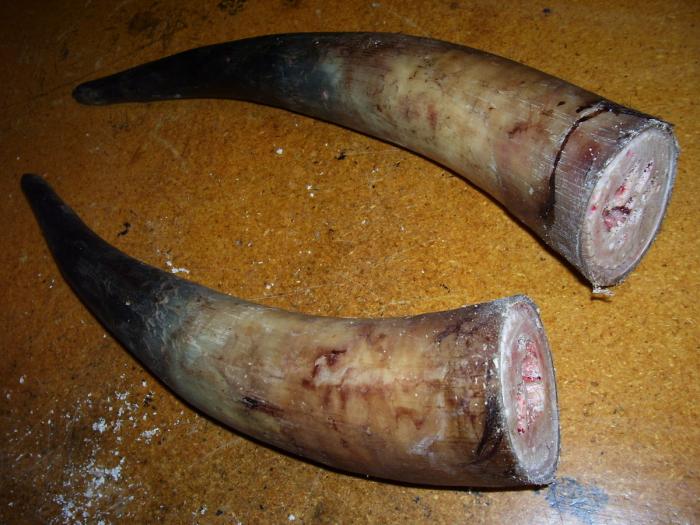
I borrowed an electric hotplate and a large enamel coated steel pot. I cranked the heat up to full power and started off by using a 12 gauge extension cord since the burner's cord was quite short. After heating for about an hour in plain water, here was the result:
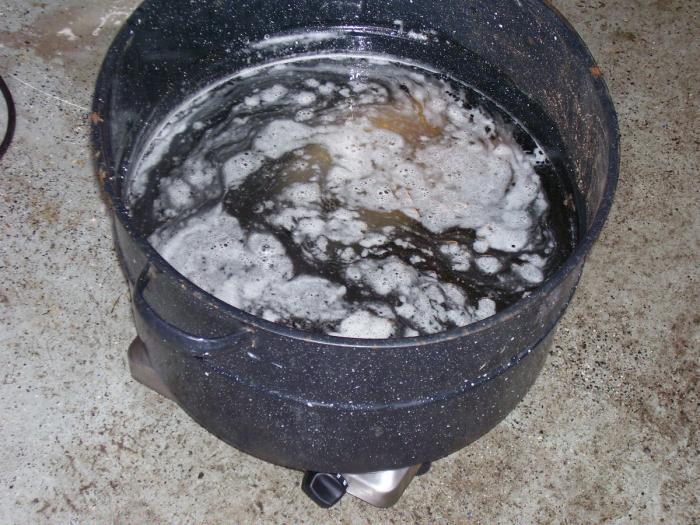
Not hot enough! I cleaned off one of my work benches and plugged the hot plate directly into an outlet. Still not hot enough. I then sealed the lid with aluminum foil and checked it periodically. The water never reached a rolling boil which was fine. The hottest the water got was a strong simmer to very very low boil. I was basically stewing the horn.
The inner core of a cow horn is bone. Between the bone and the horn is a layer of connective tissue/cartilage. This cartilage is so strong there is absolutely no way to separate the horn from the bone without using one of a handful of methods such as "cooking" the horn. This breaks down the connective tissue allowing for a difficult separation. Here is the horn during the simmer process:
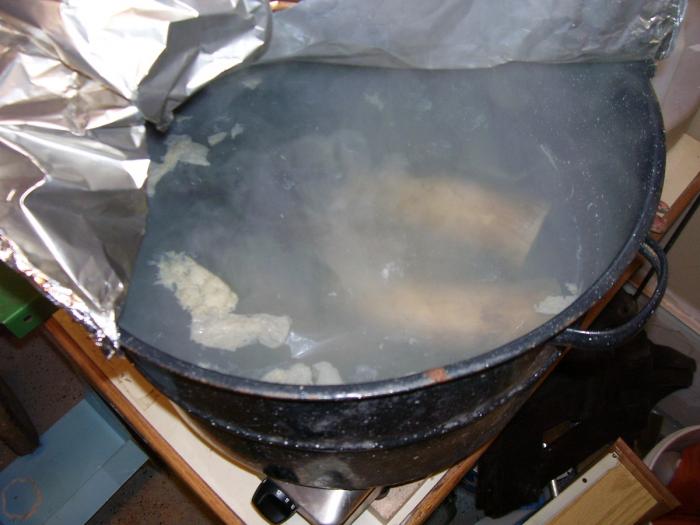
I simmered/slow boiled the pair of horn for a good 3-4 hours, maybe even more. I have a pair of 1/4" elbow length gloves that allowed me to grab the horn right out of the water, hold them and inspect the progress. I took a T handle Allen Wrench and periodically poked at the cartilage layer to gauge it's softness. I had to avoid cooking them so long that I ended up cooking the horn. I locked a 1/2" drill bit into my vice and toward the end of the process I would try to screw the bone onto the drill bit and pull the horn from the bone. Not a chance. I opted for the following tools:
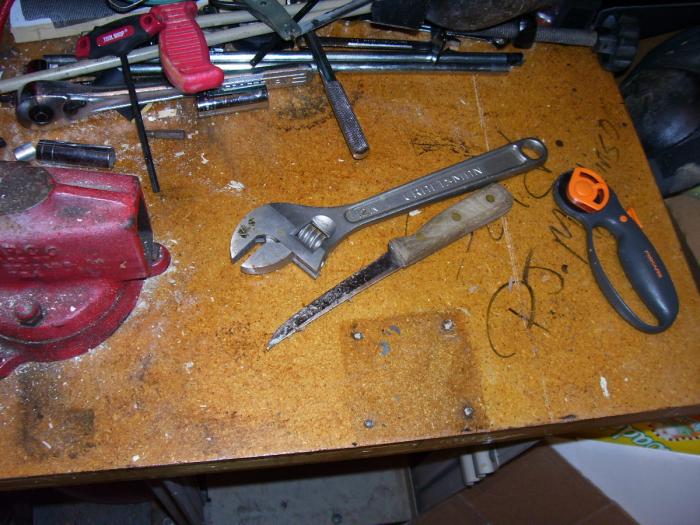
I grabbed a horn and using a rotary cutter (it holds a circular razor blade), I fairly easily slit the horn from end to almost the tip. This cattle horn was hollow all the way to the tip. Then I was able to peel and pry the horn open which FINALLY allowed me to pull out the bone fairly easily. The three byproducts of this process at this stage were the horn, the bone and the cartilage.
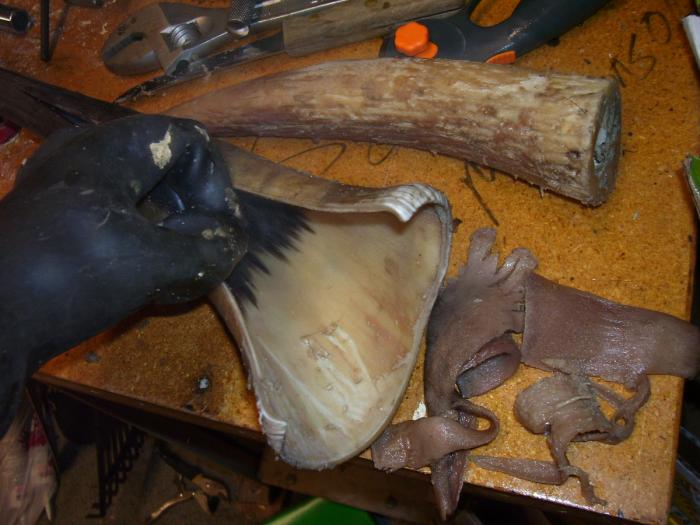
Mmmmmmm Tasty. I have no problem eating cartilage and actually enjoy it. If these horns were not sitting in my garage for months, I would have considered slicing up those chewy looking morsels and adding them to a broth based soup. But.....in the garbage it went. The horn starts to become less pliable almost within seconds from leaving the water.
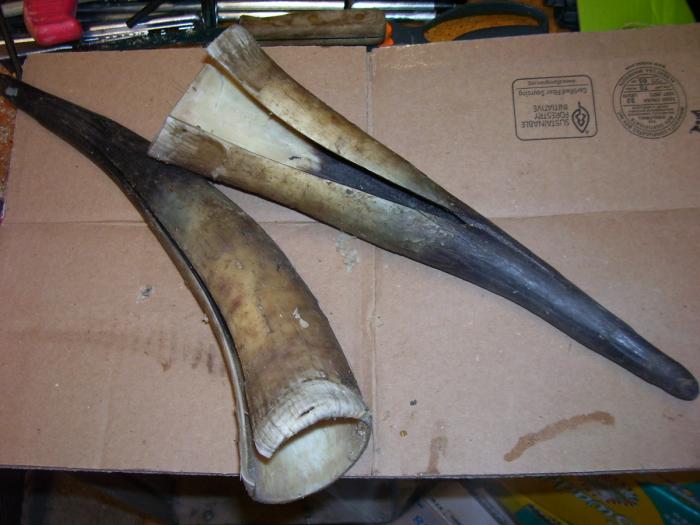
The product to date.
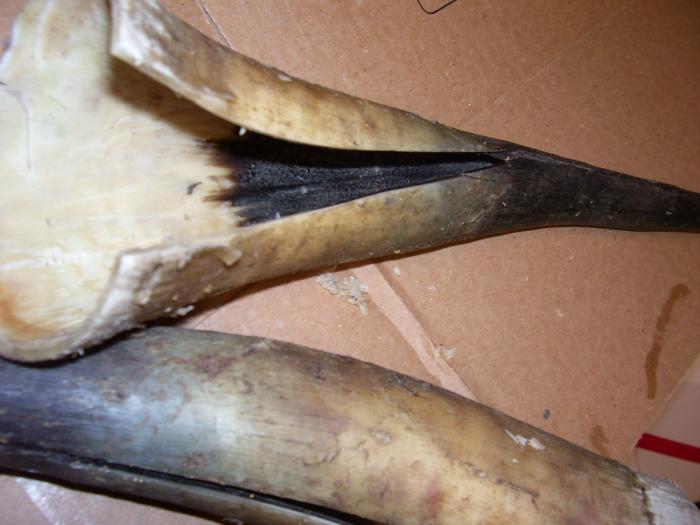
Now, I'll leave them to dry for quite awhile. Then, from there, when I have time for the next phase, I will heat them again in water long enough to cut them into slabs which will allow me to do a proper job of scraping the inside to completely clean it of the connective tissue and allow for easier sanding of the rough outer horn.
As I mentioned, there are other methods that I have not yet tried to separate the horn from the bone. Obviously for those that make powderhorns, slitting the horn up the side to separate it from the bone would be unacceptable. Other methods include submerging the horn under water for a long period of time, even months in order for the connective tissue layer to soften and essentially putrify (I've read that it is as nasty as it sounds), leaving the horn outdoors in the elements and away from vermin where the connective tissue layer eventually dries and shrinks enough to give way, or put the horn in a container with some live mealworms for flesh eating beetles to chew away the edible connective tissue.
Then, I will have to press the slabs. Who knows, maybe I'll use GWH's in an old post where he backs a car over the slab and leaves it there until cool. I'm thinking more along the lines of steel plates and a press of some sort.
So....there's the progress to date.
One more thing: You can see the open end of the horn on the left in pictures 5&6 where the horn has been cooked beyond salvage; it looks all white and squishy. Left for too long in the water, the entire horn would eventually get to that stage and be worthless. I do like the idea of trying some of the other separation methods in the future. I do not have a steady horn connection, but I should have a chance to get a few more for myself to continue experimenting.
Chris LLast edited by ChrisL; 03-17-2010 at 02:41 PM.
"Blues fallin' down like hail." Robert Johnson
"Aw, Pretty Boy, can't you show me nuthin but surrender?" Patti Smith
-
The Following 11 Users Say Thank You to ChrisL For This Useful Post:
Baxxer (09-13-2012), hardblues (03-17-2010), Jonathan (03-17-2010), Lynn (03-18-2010), matt321 (03-17-2010), Neil Miller (03-17-2010), randydance062449 (03-17-2010), Sailor (03-17-2010), ScottGoodman (03-17-2010), spazola (03-17-2010), Walt (03-17-2010)
-
03-17-2010, 04:10 AM #2

Interesting, fascinating really.
-
The Following User Says Thank You to InstaRAD For This Useful Post:
ChrisL (03-17-2010)
-
03-17-2010, 05:45 AM #3

I look forward to seeing how this turns out - thanks for posting Chris!
 Funny, as I was reading, I had the same weird thought about how (fresh cooked) cow horn cartilage might taste
Funny, as I was reading, I had the same weird thought about how (fresh cooked) cow horn cartilage might taste  but I'm afraid tasting that would have put you in the Andrew Zimmern class of adventurers.
but I'm afraid tasting that would have put you in the Andrew Zimmern class of adventurers.
-
03-17-2010, 06:30 AM #4

Thanks for interesting post.
Another way to separate the bone from the horn is to put it on the ants nest for about a week. The whole thing will come out clean and shiny. I know few knife makers that have used this method. Obviously it works only when it is summer, as all the nests are covered with 50 cm of snow.'That is what i do. I drink and i know things'
-Tyrion Lannister.
-
The Following User Says Thank You to Sailor For This Useful Post:
ChrisL (03-17-2010)
-
03-17-2010, 12:22 PM #5Hones & Honing




- Join Date
- May 2005
- Location
- Saint Paul, Minnesota, United States
- Posts
- 8,023
- Blog Entries
- 1
Thanked: 2209
Well done Chris. That looks like a nasty job! Yuck!

If I had that horn now I would make a rough oversized template of some razor scales, trace them on the horn and then use the rotary cutter to cut them out. From there I would boil and flatten the horn. Just an idea.Randolph Tuttle, a SRP Mentor for residents of Minnesota & western Wisconsin
-
The Following User Says Thank You to randydance062449 For This Useful Post:
ChrisL (03-17-2010)
-
03-17-2010, 06:22 PM #6

Very interesting stuff. Even more cool that it is from a hairy coo.
-
03-18-2010, 02:21 AM #7

This is really interesting. Horn is such a beautiful material--it's a shame that it's relatively hard to come by in razor-size pieces. Your post helps illustrate why.

Josh
-
03-18-2010, 06:09 PM #8
-
03-18-2010, 06:33 PM #9


 LinkBack URL
LinkBack URL About LinkBacks
About LinkBacks







 Reply With Quote
Reply With Quote
